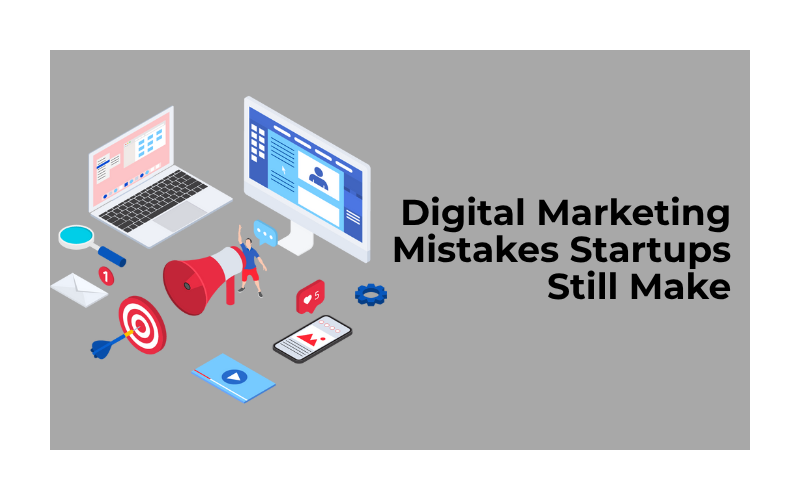In the high-octane startup environment, digital marketing can be viewed as the golden ticket to immediate upward growth and exposure. Startups have small budgets, small teams, and face big ambitions when acquiring their first users, building a brand, and gaining traction. To do so, startups increasingly rely on digital channels. Nevertheless, the fact remains that a lot of new companies still end up falling into the same digital marketing pitfalls either because they lack the experience or simply because, due to the demand to grow fast, they rush into it. Even though the number of tools, tutorials, and case studies has grown, digital marketing mistakes are still one of the most widespread ways of squandering money and losing the drive, or failing to engage people among startups.
Rushing In Without a Strategy
Leaping into digital marketing unprepared is one of the most widespread mistakes a startup can ever make. Passion has a way of substituting for strategy. A founder may choose to place Google adverts, establish an Instagram profile, or launch a blog because it appears to be the correct thing to do. However, in the absence of a clear marketing plan, all such campaigns tend to be uncoordinated and fragmented. The first steps that a startup should take are to define what business a startup wants to pursue, who its intended users are, what its most important key performance indicators (KPIs) are, and where it can find the channels that its users will care about most.
Ignoring Customer Personas
I have heard the term times and again that is not an audience, I love the problem, and this is the wrong pitch you made. However, invalidated assumptions may be an expensive venture. Construction of the digital campaigns on a poorly researched knowledge of the ideal customer profile usually leads to ineffective targeting and undirected messaging. Startups have to create specific buyer personas relying on the facts and figures-age, occupation, what hurts them, what drives them, online actions, and decision-making procedures.
Spreading Too Thin Across Too Many Channels
The other pitfall of startups is the temptation to serve everywhere at the same time. All these digital channels are possible: Google, Facebook, Instagram, LinkedIn, YouTube, TikTok, Twitter, email marketing, SEO, and content marketing, which is why it is tempting to engage them all. The traditional reasoning would include the following: the more the platforms, the more reach. However, this is a risky strategy when you are at an early stage of business, and you have low resources. Rather than having an average presence on three, si,x, or seven platforms, it is best to take command of one or two platforms on which your target market is most active. Formats, tones, and strategies also vary with each channel. Being too thin means not engaging well and burnout. New ventures are advised to start with a small number of connections, replicate the success, and diversify when bandwidth and data are available, to make the decision.
Neglecting SEO in the Early Stages
SEO Search engine optimization (SEO) is usually misinterpreted or neglected by startups that are looking out to have instant gratification. SEO is a long-term game, so lots of founders think it is something they can work on at a later stage when the product is popular enough. This is one of the main weaknesses. Creating initial solid SEO structures, such as keyword-rich material, meta-labels, web page format, and backlinks, can create huge cost savings in acquiring customers eventually. The sooner you begin guaranteeing domain authority and assuming high-quality material, the sooner you can enjoy the fruit of organic traffic. Furthermore, properly developed SEO helps to establish belief in the brand and trust of the searchers. It is too late to ignore and hope to catch up with their competitors who have started months and sometimes years earlier.
Over-Reliance on Paid Ads
Paid advertising may not take long to be successful, which explains why many startups are brutal in their use of Google Ads or social media advertising in the startup phase. This may make a clever short-term decision, but in the long term, one cannot run all channels in paid without developing a supplemental organic strategy, which is unsustainable. The ads cease working as soon as you cease paying. In the case of startups working solely with paid traffic, it is unlikely that the level of customer relationships, loyalty, or even brand equity is built. Also, there is the possibility of spending on an advertisement with no clear ROI as long as there is no adequate funnel tracking or retargeting. Paid advertising should serve as another component, along with email marketing, organic content, community building, and referral programs, as a greater strategy for a startup.

Poor Content Quality and Consistency
One of the strongest tools that startups can use in business is content marketing, although it is only effective as long as there is a proper execution of the tool. Unfortunately, the majority of startups do not realize the significance of developing valuable and original content addressing the needs of their audience. Instead, they produce general blog articles, occasional social media posts, or a minimum-effort video with limited value. And even more, they tend to give up on the content ventures after a couple of weeks since they fail to see the quick results. Excellent content is a long-term and sustainable process. It must be useful, interesting, and consistent with your brand voice. Regardless of whether the content is in the form of blog posts, newsletters, videos,/or case studies, content must be part of an intention to educate, entertain, or inspire the user. This creates trust, authority, and loyalty in the long run, so this is something that cannot be purchased using paid advertising.
Failing to Track and Analyze Performance
One of the problems that startup teams have is that they do not monitor their digital marketing. It is starting a campaign without installing analytics tools, conversion tracking, or A/B testing, which is similar to flying blind. Startups cannot know what works and what does not perform adequately because we do not have precise data. Many times, they pour time and money into strategies that bring little profit because they have not taken the time to analyze the metrics. Such tools as Google Analytics, Hotjar, and Meta Ads Manager can provide strong information about user behavior, campaign effectiveness, and conversion paths. Data is something in which startups should find focus. Being agile to adapt according to what the numbers say can make a difference between growing seamlessly and burning out.
Forgetting About the Funnel
Startups often invest far too much at the top of the funnel in brand awareness/ traffic generation practices instead of at mid and bottom of funnel practices. People do not come and visit your website to stop. When there is no strategy to foster those leads, like as sending emails, retargeting, or educational materials, they tend to bounce off never to come back. The customer does not stop with a click. It operates on levels of awareness, consideration, decision, and advocacy. A funnel should be created to take the users through the steps of their curiosity to conversion and beyond. This implies recording emails, providing lead offers, delivering follow-up calls, and timing proposals. Failing to do this bit of the journey is equivalent to leaving money on the table.
Chasing Trends Instead of Solving Problems
Digital marketing is a place of trends: viral TikTok videos, new forms of advertising, cooperation with influencers, and algorithm updates. Not paying attention to trends is good, but this is the case where most startups fail to focus on the actual issue that the customers are seeking solutions to. They can get on a meme trend, podcasting, because someone told them to do it, or NFTs that barely relate to their product. This activity can create buzz in the short run, but in many cases, it will not convert or create enduring value. Doing what is right for your audience is the key to effective marketing, not doing what is popular. Startups ought to avoid shiny object syndrome and narrow down to finding out the nature of problems facing their customers and supplying the right solution.
Final Thoughts: From Avoiding Mistakes to Building Momentum
Digital marketing is a necessary growth driver for startups, yet full of landmines in the hands of the uninitiated. Going into it unprepared, disregarding data, not learning about your target audience and depending on paid forms excessively are just some of the pitfalls of doing that can blow your work off track and suck out resources. And there is good news since all these pitfalls can be prevented. A clear strategy, solid background, and frequent implementation can allow startups to build effective digital marketing systems to convert and maintain customers within the firm.
After all, it is not about doing everything well, but rather about picking the right things and doing them well in digital marketing. The first step is knowing your audience. Construct valuable content. Measure everything. And never imbibe that your brand just becomes a logo, but rather all the experience that you deliver within all digital touch experiences.














